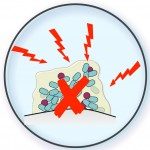Link to Pubmed [PMID] – 23027191
Antimicrob. Agents Chemother. 2012 Dec;56(12):6310-8
Biofilms that develop on indwelling devices are a major concern in clinical settings. While removal of colonized devices remains the most frequent strategy for avoiding device-related complications, antibiotic lock therapy constitutes an adjunct therapy for catheter-related infection. However, currently used antibiotic lock solutions are not fully effective against biofilms, thus warranting a search for new antibiotic locks. Metal-binding chelators have emerged as potential adjuvants due to their dual anticoagulant/antibiofilm activities, but studies investigating their efficiency were mainly in vitro or else focused on their effects in prevention of infection. To assess the ability of such chelators to eradicate mature biofilms, we used an in vivo model of a totally implantable venous access port inserted in rats and colonized by either Staphylococcus aureus, Staphylococcus epidermidis, Escherichia coli, or Pseudomonas aeruginosa. We demonstrate that use of tetrasodium EDTA (30 mg/ml) as a supplement to the gentamicin (5 mg/ml) antibiotic lock solution associated with systemic antibiotics completely eradicated Gram-positive and Gram-negative bacterial biofilms developed in totally implantable venous access ports. Gentamicin-EDTA lock was able to eliminate biofilms with a single instillation, thus reducing length of treatment. Moreover, we show that this combination was effective for immunosuppressed rats. Lastly, we demonstrate that a gentamicin-EDTA lock is able to eradicate the biofilm formed by a gentamicin-resistant strain of methicillin-resistant S. aureus. This in vivo study demonstrates the potential of EDTA as an efficient antibiotic adjuvant to eradicate catheter-associated biofilms of major bacterial pathogens and thus provides a promising new lock solution.


